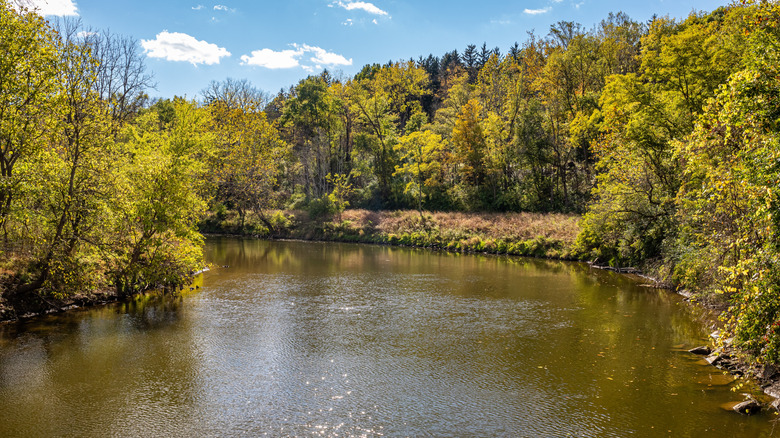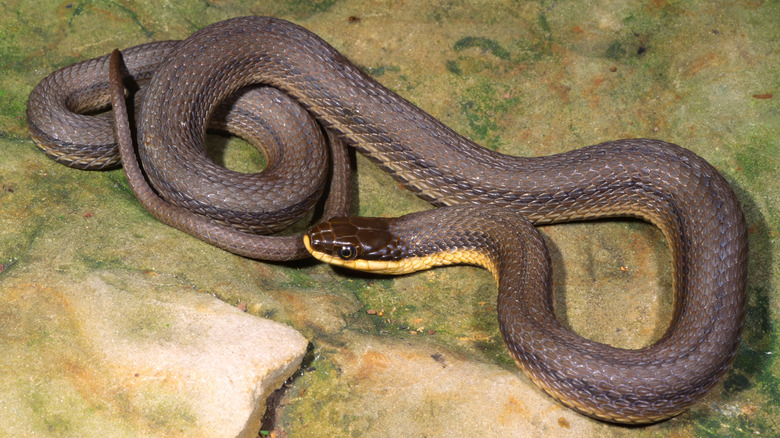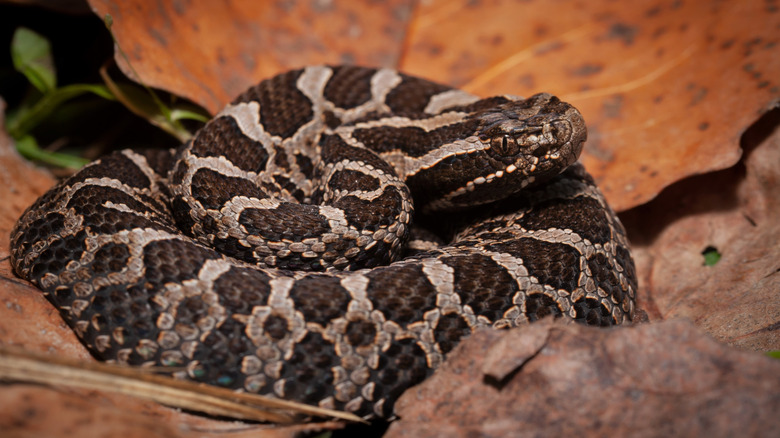Ohio's Most Snake-Filled Lakes And Rivers Are Hiding In Plain Sight
Home to grasslands, canyons, marshes, and other ecosystems, it should come as no surprise that Ohio is just a paradise for snakes. With 25 native snake species — several of which are either aquatic or semi-aquatic — iconic destinations like Lake Erie's lakeside towns and sandy beaches might render an unexpected encounter with these reptiles. The same can be said for some of the rivers within the Buckeye State.
Don't worry though, as only three types of venomous snakes can be found in all of Ohio. Those are the Northern copperhead, the Eastern massasauga rattlesnake, and the timber rattlesnake. If you see a snake, even in an area where venomous snakes have not been spotted, it's a good idea to keep your distance. If you are bitten by a snake, call 911. Move away from the snake, remove any jewelry, watches or tight clothing, and sit or lie down in a comfortable position. If possible, wash the area with soap and water, and wrap it loosely with a clean, dry bandage.
After learning about the many snake species in Ohio, planning a getaway to the state's picturesque countryside and tranquil lakes might sound frightening. However, it's important to highlight that snakes are not out to get you or harm you in any way. In fact, running into one is unlikely and snakes won't attack unless you bother them. So, if by any unfortunate reason you run into one of these reptiles, just keep your distance. Still — just so you can get somewhat of an idea as to which lakes and rivers in Ohio are snakes' favorites — here's a quick list that can help you plan your next Midwest outdoor adventure.
The famous Lake Erie is a certain favorite of snakes
Lake Erie is a great place for some outdoor recreation and water activities, especially during the summer months. Boating, kayaking, fishing, and swimming are all popular activities. Lake Erie's southern Ohio shores are also home to the town of Conneaut, a scenic village with the Great Lakes' oldest lighthouse. And yes, Lake Erie also has snakes. You can still enjoy a peaceful summer vacation here, though. In fact, there are only four species you might encounter while visiting this Great Lake — none of them venomous. The venomous Eastern massasauga rattlesnake has been spotted along Michigan's Great Lakes region, so it wouldn't hurt to keep an eye out for this particular species just in case.
The four species found at Ohio's Lake Erie are the common water snake, the Lake Erie water snake, the eastern fox snake, and the common ribbon snake. The Lake Erie water snake is mostly found by boaters, according to Ohio's authorities. However, they can also be found on the islands as well as the rocky shoreline of the lake's western edge. The common or eastern ribbon snake, for example, prefers wetlands and other shallow-water habitats.
As for other lake residents — such as the eastern fox snake — know that this species is endangered and can also be found at Lake Erie's Canadian shores. Another interesting fact about this species is that when it feels threatened it mimics a rattlesnake, yet it is totally harmless. Fox snakes are normally seen sunbathing on roads, and despite its unnerving defense mechanism, please remember to be gentle and avoid harming them in any way.
The Ohio and Cuyahoga Rivers
The Ohio River is home to a variety of snake species, both venomous and non-venomous. This river is also home to many other wildlife species, including birds, small mammals, and, of course, fish. This abundance of food makes it an ideal habitat for snakes. And since about 25 million people inhabit the 981 miles that the river flows through, it's only natural that someone will run into these reptiles eventually.
Some of the species found along the Ohio River include the northern water snake, queen snake, and Kirtland's snake, among others — all of which are harmless and mostly feed off the local wildlife. The Ohio River is home to the venomous eastern timber rattlesnake as well, which is found in forested areas as well as in floodplains.
As for Cleveland's Cuyahoga River — where the grand Detroit-Superior bridge offers stunning city views — you'll find species like the queen snake or the ribbon sake. The northern water snake might also be a common find. Be cautious if you see a snake in the area. According to the National Park Service website, the Eastern massasauga and northern copperhead have been spotted in areas nearby the Cuyahoga valley.
Salt Fork Lake is also a favorite of Ohio's snakes
Salt Fork Lake can be reached by driving north for about 13 minutes on US Route 22 from Cambridge — Ohio's beloved city in the foothills of the Appalachians. This body of water is huge, stretching for 3,000 acres. The lake offers visitors a wide range of activities to enjoy such as hiking, boating and kayaking, fishing, and much more. It's also part of the Salt Fork State Park, where you'll find a golf course as well as the Salt Fork Lodge.
Rumor has it that Bigfoot also makes an appearance within the park. But considering that snakes also like to call both the park and lake their home, maybe this giant will be too scared to show itself during your visit. But don't worry, as neither you nor Bigfoot have any reason to be scared of the lake's harmless northern water snake, queen snake, ringneck snakes, or the black racers found in wooded areas.
The closest major airport to the city of Cambridge is the John Glenn Columbus International Airport (CMH). This airport stands an hour and fifteen minutes away from Columbus, where America's largest but underrated rose-filled park is located.
The Maumee River flowing into Lake Erie
Another favorite of Ohio's snakes is the Maumee River near the city of Toledo. What makes the river such a nice place for snakes is that plenty of fish also reside there. The Maumee River is actually a favorite of fishermen for this same reason, yet visitors can also engage in many other activities like boating and camping.
The Maumee River eventually flows into Lake Erie, so you can expect to see the same snake species both along these 130 miles of flowing waters and in the lake. This is especially true during the spring and early summer, when the walleye fish start making their way upstream, coinciding with the local snakes' breeding season. There's plenty of snake food at that time, and with so many fishermen attending what is called as the "Walleye Rush," it's only natural that an encounter with these animals is due sooner rather than later.
Once again, there's no need to worry, though. Most of the snakes found at the Maumee River are the non-venomous northern water snakes, the Lake Erie water snakes, and the eastern hog-nosed snake, among others. However — and just as a precaution — do be on the lookout for both the timber rattlesnake and Eastern massasauga. Although these specific encounters are uncommon, both species can be found near Toledo.
Mosquito Creek Lake near Cortland
A very short six-minute drive from Cortland in Northeastern Ohio will deliver you to Mosquito Creek Lake. Being one of the largest bodies of water within the Buckeye State and surrounded by marshes and other thriving ecosystems, it's no wonder many snakes make their home along these shores. Some of the species that can be found here include the aforementioned northern water snakes — commonly seen in their search for small fish and amphibians — the eastern fox snake, and the copper-bellied water snake as well. The venomous Eastern massasauga also calls the lake and its surrounding woodlands its home, so caution should be exerted when visiting.
As for the activities you can enjoy while visiting Mosquito Creek Lake, boating, camping, swimming, and fishing are some of the most popular ones. Since the lake is also part of the Mosquito Creek State Park, you can also expect to find several trails perfect for hiking around the lake and its marshes.
Winter sports are also available as soon as temperatures start to drop, with skating, skiing, and even snowmobiling being a top choice among visitors. Finally, the Mosquito Creek Reservoir Wildlife Area can be found in close proximity to the lake. With more than 1,300 acres of wilderness, it is also an amazing place to visit for enjoying some more outdoor adventures.





